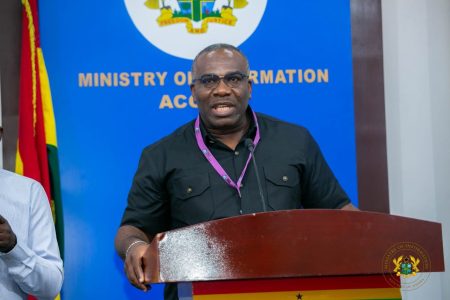The Volta River Authority (VRA) has committed to restore lifestyles and livelihoods of victims of flooding caused by unavoidable spillage of Akosombo and Kpong Dams in the shortest possible time.
It promised to continue to do over and above what is required, to preserve the precious lives and make life comfortable for them.
So far, the Authority has committed GH₵20 million towards alleviating the adverse impact on the affected communities.
Deputy Chief Executive of VRA in charge of Engineering and Operations, Ing. Edward Obeng-Kenzo, said “there will be no additional increase of spillage. We are tracking the data that is coming, and we are going to control the gates per the data that we receive.”
Interventions rolled out
Updating the public at the Minister’s Media Briefing in Accra, he listed a litany of interventions and measures that VRA together with other agencies is taking to relieve the affected communities in the meantime.
He promised that delivery of relief items to safe havens and in most cases, those who have lost their livelihoods which started since October 10 is continuing unabated.
Food, drugs, tents, potable water, improved sanitation
According to him, food, drugs, tents, potable water, improved sanitation and other essential items have been delivered to the affected people.
He said for instance, that they had made sure that there is enough water being supplied to communities around Aveyime.
Ing. Obeng-Kenzo also stated that new pumping stations have been brought in to replace the existing ones that were inundated by the floods.
He also divulged that a water purification system had been installed at the St Kizito School in Mɛƒɛ to supply residents with clean water.
Furthermore, he said that water tanks have been supplied and filled with water from other communities to bring fresh water to the displaced.
Restoring electricity supply
According to him, VRA is also working with the Electricity Company of Ghana (ECG) to restore electricity to the community.
5-kilometre road constructed
In order to ease transportation, they have constructed a five kilometre road to enable free movement of goods and persons.
Healthcare team deployed
To prevent deaths from diseases, Ing. Obeng-Kenzo stated that a hospital team had been deployed to the community to cater for the sick.
VRA has provided GH₵ 1.5 million worth of medicines have been supplied to affected communities in the Akosombo Dam spillage.
The District Health Directorate of the Ghana Health Service is facilitating the distribution of the medicines to affected communities.
5,000 solar lamps distributed
According to the engineer, VRA has also distributed about 5,000 solar lamps to ease visibility courtesy the Ministry of Energy.
Portable toilets provided
Ing. Obeng-Kenzo said affected persons have also been given about 450 portable toilets, which are being managed by waste management company, Zoomlion.
He alluded to hearing reports of people who are yet to receive relief items or support and urged such affected persons who require assistance to reach out through helplines put out by NADMO and Information Ministry so that the due assistance will be given to them.
He assured Ghanaians, particularly victims that VRA shares in their pain, discomfort and hardships.
“It is our expectation that as the rains come to an end we will reduce the spill rate, the floods will recede and people can return to their homes and resume their normal lives.
“We are grateful to all the stakeholders, in particular, NADMO, Ministry of Energy, Ghana Armed Forces, Ministry of Health, the Press and all those who have assisted in bringing relief to our compatriots during this period. We are also grateful to the affected people for their forbearance,” he stated.
Too early to determine the overall cost
Deputy Minister of Information, Fatimatu Abubakar, on her part said it is too early to determine the overall cost that will be involved in restoring these communities to their pre-flooding states.
According to her, “Until the water levels go very down and you are able to assess the extent of damage to property and quantify what people have lost, you may just speculate and put out some figures, and later on when you come back to inform the people that you may require double or triple, they may accuse you of mismanagement.”
The Deputy Minister continued, “We are keeping faith with the data that will be provided after the water levels are completely down and the proper assessments are made.”
She however assured that all the Ministries who are in one way or another responsible for some aspect of the issue will chip in with whatever resources they can muster.
Over 36,000 victims
According to latest figures, over 36,000 people have been affected so far.
Affected districts
The districts affected include North Tongu, Central Tongu, South Tongu, Anlo and Keta Municipality, in the Volta Region.
The rest are Asuogyaman and Lower Manya Krobo in the Eastern Region, and Shai Osudoku and Ada East, in the Greater Accra Region, with Mɛƒɛ, in the North Tongu District being the worst hit community.
Key timelines and events
In early September, the Ghana Meteorological Agency (GMet), said real-time data indicated that above normal rains from the Sahelian countries will necessitate the spillage of the Akosombo Dam.
The situation had been compounded by above normal rainfall distribution in the North Eastern part of the country.
GMet forecast published on September 4
On September 4, 2023, GMet published its forecast, notifying all stakeholders, including the Volta River Authority (VRA), Ghana Health Service and the National Disaster Management Organisation (NADMO) about the above normal rainfall distribution.
Water from 6 tributaries
These multiple sources of water from six tributaries including the White and Black Volta, flowing into the Akosombo Lake from Mali, Burkina Faso, Togo and Benin, and those from the North East region have been the problem.
The spillage began on September 15, 2023, at a low rate for about one and a half weeks with no impact on downstream communities.
However, the inflow into the reservoir continued to increase at a higher rate, and therefore there was the need to increase the spill rate in order to slow down the rate at which the reservoir elevation was rising.
The volumes of water that were coming into the lake imposed on the Authority the obligation to save the dam from collapse and at the same time evacuate people and ensure their safety.
Maximum water level
The maximum level of water in the Akosombo Dam should be 276 feet.
But, as of Thursday October 12, the water level in the dam was 276.92 feet or 84.405 metres.
It got to a point where it would have been above the capacity of the dam so it was impossible to store any more water.
The controlled spillage of water from the Akosombo and Kpong Dams was due to high inflows into the reservoir, resulting in the water level exceeding its upper level.
This has resulted in the flooding of some communities downstream of the Dams as roads are cut off leaving commuters stranded, with others resorting to the use of boats and canoes which further endanger their lives.
The spillage is a standard operation for any hydro dam to prevent the water from overtopping and compromising the integrity of the dams.
VRA stores a lot of water through the inflow systems. That is why spilling is not a recurring thing that it does.
Years water was spilled
Prior to this year, water from the dam had been spilled in 1966, 1967, 1968, 1969, 1970, 1971, 1972, 1974, 1991 and 2010.
VRA issued four press releases within 15 days
VRA issued four press releases within 15 days, specifically on September 5, 12, 15 and 20, cautioning all residents along the Volta River and downstream of the Akosombo and Kpong Dams to take the necessary precautionary measures to avoid being adversely affected by the spillage
September 5 caution press release
On September 5, 2023, a VRA statement warned about potential flooding due to the spillage from Bagre Dam in Burkina Faso, coupled with coupled with high rainfall in northern Ghana.
This was based on information received from SONABEL, the power utility of Burkina Faso.
Accordingly, VRA asked all stakeholders, residents, Chiefs, opinion leaders, security agencies, as well as the general public to take note of this flood alert and take the necessary precautionary measures to avoid being adversely affected by the spillage from the Bagre Dam.
September 12 caution press release
Seven days later, the VRA released another statement on September 12 informing the general public that it had observed a consistent rise in the inflow pattern and water level of the Akosombo dam.
In line with its Emergency Preparedness Plan (EPP) and Standard Operating Procedures (SOPs), the VRA duly notified its key stakeholders of this development.
It said the reservoir level suggested the need to commence controlled spilling in the coming days, should the situation persist.
Again, the VRA cautioned all residents along the Volta River and downstream of Akosombo and Kpong Dams to be on alert and take the necessary precautionary measures.
At this point, VRA said all EPP protocols were activated and notifications sent directly to EPP responders on commencement of spilling from September 15.
September 15 caution press release
For the third time, VRA on September 15 issued another statement.
This time, the Authority announced the commencement of controlled spillage at the Akosombo and Kpong Dams effective September 15, 2023.
It observed that heavy rains being experienced across the country leading to some levels of flooding and high water levels in some communities, informed the decision to undertake controlled spillage to mitigate any adverse impacts.
On the same day, the VRA said its officials and NADMO staff visited downstream communities to assess the level of impact and continue monitoring.
September 20 caution press release
On September 20, the VRA released a fourth statement in which it said it had become necessary to increase the spillage volume due to the rising water level upstream of the Akosombo Dam.
VRA added that as required by the EPP, it was collaborating with all the relevant stakeholders to educate and inform the downstream communities to minimise any potential impacts.
Simulation exercise carried out in May
In May, the VRA also conducted a spill management simulation exercise dubbed, ‘Da Wo Ho So 2023’ in nearby districts, including, Asuogyaman, Ada East and Mepe in North Tongu.

